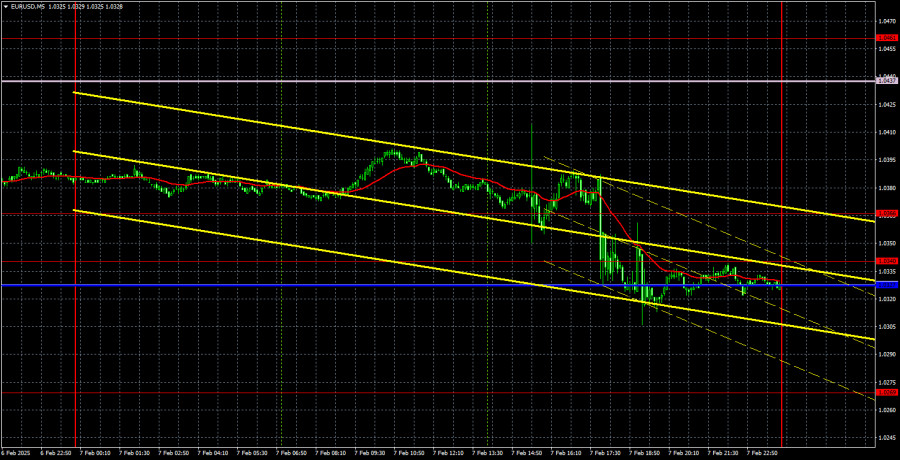EUR/USD 5-Minute Chart Analysis
The EUR/USD pair demonstrated logical price movements on Friday, although the US dollar ultimately strengthened by the end of the day. However, its gains were not particularly strong, as US macroeconomic data was not entirely positive.
The Nonfarm Payrolls (NFP) report for January showed only 143K new jobs, falling short of the minimum expected 170K. However, the December figure was revised up to 307K, making the overall report decent. The unemployment rate unexpectedly dropped to 4%, a result nobody anticipated. However, the University of Michigan Consumer Sentiment Index declined to 67.8 points, which is a negative signal. Overall, stronger labor market data outweighed weaker sentiment readings, but the US dollar failed to post a significant rally, which was a logical outcome.
From a technical standpoint, the hourly chart remains unchanged. The recent local downtrend ended, the trendline was broken, and a correction began, just as expected.
For the new week, we anticipate a new upward wave, as the correction on the daily timeframe is still weak. Corrections can be complex, often appearing as either a minor trend or a sideways movement. Currently, the daily and H4 charts suggest more of a choppy market structure rather than a clear trend.
On the 5-minute timeframe, several trading signals emerged on Friday, but none were worth executing. The first signal formed during the US trading session, coinciding with the release of employment data. During such periods, it is risky to enter trades due to heightened market volatility. Later, the pair consolidated within the 1.0327–1.0366 range, where it remained until the market closed.
Commitments of Traders (COT) Report
The latest COT report (February 4) confirms the bearish shift in market sentiment. The net position of non-commercial traders (hedge funds, speculators) had remained bullish for a long time, but bears eventually took control. Two months ago, the number of short positions held by institutional traders increased sharply, turning the net position negative for the first time in a long time. This indicates that the euro is now being sold more frequently than bought.
We still see no fundamental factors supporting a long-term recovery of the euro. The recent upward movement on the weekly chart is barely noticeable, suggesting it was just a correction. The 16-year-long downward trend remains intact. The red and blue lines in the COT report have crossed, signaling a shift to bearish sentiment.
During the last reporting week, long positions (buy trades) in the Non-commercial group increased by 8.9K contracts. Short positions (sell trades) rose by only 0.9K contracts. As a result, the net position increased by 8K contracts, but this did not impact the overall bearish trend.
EUR/USD H1 Chart Analysis
On the hourly timeframe, the local downtrend has ended, as the downward trendline was broken. We expect further declines in the medium term, as the Federal Reserve may only cut rates 1–2 times in 2025, which is a much more hawkish outlook than markets had anticipated. However, in the short term, we may see one or two more upward waves before the downtrend resumes. Fundamentally, the euro still lacks strong bullish drivers, but technical corrections are taking place.
On February 10, the following levels are highlighted for trading: 1.0124, 1.0195, 1.0269, 1.0340–1.0366, 1.0461, 1.0524, 1.0585, 1.0658–1.0669, 1.0757, 1.0797, 1.0843, as well as the Senkou Span B (1.0372) and Kijun-sen (1.0340)
Ichimoku indicator lines may shift during the day, so traders should adjust accordingly. Always set a Stop Loss to breakeven if the price moves 15 points in the correct direction, to minimize risk from false breakouts.
The only major scheduled event is a speech by ECB President Christine Lagarde. However, this is expected to be a formal event with little market impact, as the ECB meeting concluded recently and already provided all necessary policy insights.
Chart Explanations
- Thick red lines – major support and resistance levels where price reversals may occur.
- Ichimoku indicator lines (Kijun-sen, Senkou Span B) – Strong support/resistance levels from the 4-hour chart.
- Thin red lines – extreme levels where price has previously bounced. These serve as potential trade signals.
- Yellow lines – trendlines, channels, and other technical formations.
- COT Indicator (on charts) – Shows the net position of each trader category.












